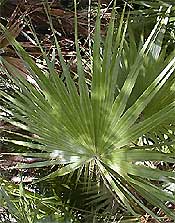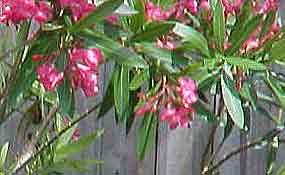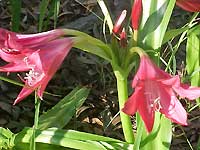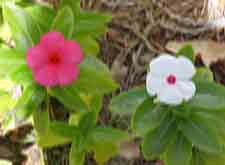Saturday, August 28, 2004
Transplanted palms
 When we first moved in about two years ago, we were awed by the gorgeous view but also a bit daunted by the work that needed to be done inside. The yard we felt could take care of itself so we could concentrate on replacing the kitchen and removing old carpet. There were a couple of volunteer palms by the garage wall and in the blowout area under the house, but we agreed that they would not grow so quickly that we needed to be worried. Fast forward two years later. We have been working on both the inside and outside of our home as we can. The gardens are looking better all the time and we have added a pool to the backyard. The volunteer palms, however, have reached a point where we agreed it was time to relocate them.
When we first moved in about two years ago, we were awed by the gorgeous view but also a bit daunted by the work that needed to be done inside. The yard we felt could take care of itself so we could concentrate on replacing the kitchen and removing old carpet. There were a couple of volunteer palms by the garage wall and in the blowout area under the house, but we agreed that they would not grow so quickly that we needed to be worried. Fast forward two years later. We have been working on both the inside and outside of our home as we can. The gardens are looking better all the time and we have added a pool to the backyard. The volunteer palms, however, have reached a point where we agreed it was time to relocate them.
Saturday dawned hot, humid and sunny and we decided it was time to move the palms. Armed with shovels and water, we started digging. The first palm was about 4 feet tall and almost as wide in expanse. It took my husband about 1/2 hour to dig around it without damaging roots. Together we rocked it until it was easily removed. We decided we wanted it in the corner of the yard where it would get roughly the same exposure, dug a hole, and placed it gently in its new home. The second and smaller palm was right at the garage wall, so we needed to be a bit more careful in its removal. The best place for that baby was in a huge pot we had placed on a step near the pool. We carefully dug that palm out and placed it in its pot, then watered both thoroughly.
A week later both are doing well, one small brown leaf on the bigger palm and none on the smaller so I think they are adapting to their move. Now comes the time for identification. I was under the impression that these palms were sabal palms, or more commonly referred to as cabbage palmettos. They are actually acoelorrhaphe wrightii paurotis palms or fan palms. The palms are very similar in appearance. The cabbage palmetto is the Florida state tree, growing 60-80 feet in height and tolerant of many conditions including salt. The fan palm, also widely identified as a saw cabbage palm, is a native of the Florida Everglades, has good salt tolerance but only grows about 30-40 feet in height. The only other difference than height is that the fan palm is clump-forming meaning that it is multi-stemmed. It is often used to soften corners or fill spaces along ponds. Anyway, the long and short of it, so to speak, is that the palms are identified and are doing well in their first week of relocation. We're keeping a close eye on them and look forward to sharing their progress as the summer/fall progresses. Happy Florida Gardening.
Saturday, August 21, 2004
August gardening
Gardening in Florida in August. Whoa! With all of the moisture in the air from the recurring storms, it is as muggy as a steam bath right now. We decided last night we would get up early and do some much needed yard cleanup today. Early for us is about 7:30, but of course we had to have coffee and read the paper first. So, that put us outside about 9:30. So, I fired up the mower and Harlan started digging some holes for the new plants we brought home. By the time the first hole was ready and I had gotten the side yard mowed, we were panting like we'd just run a mile. The perspiration was just dripping off my head and we were chugging bottles of water like crazy. By the time the fifth shrub was planted and the front yard completely mowed, we were practically crawling to the little refrigerator in search of cool water. In fact, it was so miserable outside we didn't even want to jump into the pool to cool off. We couldn't wait to get into the air conditioning. Now, that's pretty bad. I truly can't remember it being this bad in August since we moved here over 8 years ago. There are probably folks out there who will say it has been worse even earlier in the year, but my memory only works year to year so I'm sticking to my story.
 Anyway, the effort was worth it. The yard looks much better and the neighbor's gas tank is now covered from view with gorgeous oleander. We went to Home Depot yesterday and purchased two 4' tall oleanders in hot pink and pale pink. They generally grow up to 30 feet and spread about 15 feet, but since these are planted under the canary palm I lamented about last month my plan is to keep them trimmed to about 7'. I love oleander, as you well know from the Ollie rescue we performed earlier this year, and it doesn't disappoint. Oleander will bloom from spring to fall and the only thing you need to worry about is caterpillars. While I'm thinking about it let me give you an Ollie update. The poor boy hunkered down and decided not to do much of anything this year. So I went out this afternoon after the clouds moved in and trimmed him down to about half the size he was when we brought him home. There's still plenty of green in his limbs and I'm hoping he'll reward us with some new growth as the weather gets cooler. I'll let you know.
Anyway, the effort was worth it. The yard looks much better and the neighbor's gas tank is now covered from view with gorgeous oleander. We went to Home Depot yesterday and purchased two 4' tall oleanders in hot pink and pale pink. They generally grow up to 30 feet and spread about 15 feet, but since these are planted under the canary palm I lamented about last month my plan is to keep them trimmed to about 7'. I love oleander, as you well know from the Ollie rescue we performed earlier this year, and it doesn't disappoint. Oleander will bloom from spring to fall and the only thing you need to worry about is caterpillars. While I'm thinking about it let me give you an Ollie update. The poor boy hunkered down and decided not to do much of anything this year. So I went out this afternoon after the clouds moved in and trimmed him down to about half the size he was when we brought him home. There's still plenty of green in his limbs and I'm hoping he'll reward us with some new growth as the weather gets cooler. I'll let you know.
We also picked up three red ixoras to place along the fence closer to the street. They will grow to about 5' in height and width, just enough to almost cover the fence entirely. The great thing about ixora is that it is a happy plant and will bloom pretty much year round once established. We had great luck with ixora at our other house so I know this will be a good choice here.
There are still two red and two white fountain grasses we need to plant in the back yard. The intent was to get them into the garden today, but you know the old saying about good intentions especially in this weather. So we've agreed to get up early again tomorrow and try again. We may wind up with the same result, but at least we'll be a little closer to the pool - we can just fall in. Happy Florida Gardening.
 Anyway, the effort was worth it. The yard looks much better and the neighbor's gas tank is now covered from view with gorgeous oleander. We went to Home Depot yesterday and purchased two 4' tall oleanders in hot pink and pale pink. They generally grow up to 30 feet and spread about 15 feet, but since these are planted under the canary palm I lamented about last month my plan is to keep them trimmed to about 7'. I love oleander, as you well know from the Ollie rescue we performed earlier this year, and it doesn't disappoint. Oleander will bloom from spring to fall and the only thing you need to worry about is caterpillars. While I'm thinking about it let me give you an Ollie update. The poor boy hunkered down and decided not to do much of anything this year. So I went out this afternoon after the clouds moved in and trimmed him down to about half the size he was when we brought him home. There's still plenty of green in his limbs and I'm hoping he'll reward us with some new growth as the weather gets cooler. I'll let you know.
Anyway, the effort was worth it. The yard looks much better and the neighbor's gas tank is now covered from view with gorgeous oleander. We went to Home Depot yesterday and purchased two 4' tall oleanders in hot pink and pale pink. They generally grow up to 30 feet and spread about 15 feet, but since these are planted under the canary palm I lamented about last month my plan is to keep them trimmed to about 7'. I love oleander, as you well know from the Ollie rescue we performed earlier this year, and it doesn't disappoint. Oleander will bloom from spring to fall and the only thing you need to worry about is caterpillars. While I'm thinking about it let me give you an Ollie update. The poor boy hunkered down and decided not to do much of anything this year. So I went out this afternoon after the clouds moved in and trimmed him down to about half the size he was when we brought him home. There's still plenty of green in his limbs and I'm hoping he'll reward us with some new growth as the weather gets cooler. I'll let you know.
We also picked up three red ixoras to place along the fence closer to the street. They will grow to about 5' in height and width, just enough to almost cover the fence entirely. The great thing about ixora is that it is a happy plant and will bloom pretty much year round once established. We had great luck with ixora at our other house so I know this will be a good choice here.
There are still two red and two white fountain grasses we need to plant in the back yard. The intent was to get them into the garden today, but you know the old saying about good intentions especially in this weather. So we've agreed to get up early again tomorrow and try again. We may wind up with the same result, but at least we'll be a little closer to the pool - we can just fall in. Happy Florida Gardening.
Sunday, August 15, 2004
A crinum lily identified
 Now that the hurricane threat has mercifully passed, it's time to begin identifying more plants growing in my garden. There have been gorgeous lilies blooming in the side garden that I could not identify. At first I thought it was a Crinum, but the leaves did not fit the description in most of my reference books. The leaves of these lilies are strap-shaped and the blooms come up on a thick stalk of about 8 buds. The pictures I had seen as well as the lilies in the stores all had sword-shaped leaves. Well, sure enough I found out it truly is a Crinum lily and appears to be a Crinum bulbispermum or an Ellen Bosanquet. How did I find out? My friends at Plant Delights Nursery. There on page 13 of their latest catalog was a beautiful full color picture.
Now that the hurricane threat has mercifully passed, it's time to begin identifying more plants growing in my garden. There have been gorgeous lilies blooming in the side garden that I could not identify. At first I thought it was a Crinum, but the leaves did not fit the description in most of my reference books. The leaves of these lilies are strap-shaped and the blooms come up on a thick stalk of about 8 buds. The pictures I had seen as well as the lilies in the stores all had sword-shaped leaves. Well, sure enough I found out it truly is a Crinum lily and appears to be a Crinum bulbispermum or an Ellen Bosanquet. How did I find out? My friends at Plant Delights Nursery. There on page 13 of their latest catalog was a beautiful full color picture.
Crinum lilies are Florida natives and pretty easy to grow. They supposedly do well in full sun or semi-shade and adapt to either dry or wet soil. When we moved here, there were two or three clumps planted among a huge weed bed. I separated the bulbs and spread them around throughout the front and side gardens. What I have found is that the lilies in the semi-shade bed fare better than those in the full sun garden. I'm not quite sure why since they have been treated the same for food and water - the only difference is the amount of sun they receive. The lilies in the front garden have never flowered while those on the side have flowered twice. When it gets a bit cooler, I may relocate those in the front and let them join their sisters in the other garden. We'll see then how well they do. Happy Florida Gardening.
Monday, August 09, 2004
What's up with that?
 I was reading the gardening section of the paper the other day and someone had written in complaining about brown spots on their plant. Apparently, they had a begonia that was a houseplant. As the weather got warm, this person decided that the plant really wanted to be outside. So, they placed the begonia outside in the sun and proceeded to watch the leaves get brown spots. What's up with that? This is Florida, for goodness sake. If a person takes their houseplant out of their normal conditions and puts it outside in 90 degree weather in full sun, what do they expect? It's like taking an ice cube and putting it on the sidewalk. It's going to melt, no surprises there. So what in the world can someone be thinking when they take a plant out of a protected, temperature-controlled environment and place it outside under the Florida sun?
I was reading the gardening section of the paper the other day and someone had written in complaining about brown spots on their plant. Apparently, they had a begonia that was a houseplant. As the weather got warm, this person decided that the plant really wanted to be outside. So, they placed the begonia outside in the sun and proceeded to watch the leaves get brown spots. What's up with that? This is Florida, for goodness sake. If a person takes their houseplant out of their normal conditions and puts it outside in 90 degree weather in full sun, what do they expect? It's like taking an ice cube and putting it on the sidewalk. It's going to melt, no surprises there. So what in the world can someone be thinking when they take a plant out of a protected, temperature-controlled environment and place it outside under the Florida sun?
Another example of not quite understanding how plants can be affected by their environment. My husband and I decided we wanted breakfast and visited a restaurant close to our home. As we were paying the bill, the server lamented how the beautiful plants in the planters by the door were not doing well. I glanced outside and noticed the celosia was brown like straw and the coleus was drooping. There were also some other greens, like philodendron in the pots that seemed to be holding their own. She explained that she was doing exactly what the tags that came with each plant told her to do but they just weren't looking very good. I told her celosia was a bit difficult to grow, depending on its conditions, but coleus was as easy for an outside gardener as philodendron is to an inside gardener. It pretty much takes care of itself once established. I began asking her how she was watering, what type of exposure she was providing, etc. First, she plopped a bunch of plants into pots because they looked pretty together but not considering each had its own growing needs. Second, and the biggest factor, she was taking them in and out everyday because she was concerned they would get stolen. The plants were put outside in the sun and heat at 7 AM every morning and brought back into the air conditioned shaded interior every day around 3PM. So, the plants' conditions were changing every day, they were being watered like crazy, and she couldn't figure out why they were dying.
As we all know, Florida can be difficult on plants. But it just takes a little common sense on understanding what could affect a green living thing if its environment is changed and/or if it's placed with other plants that don't have similar needs. If the woman with the begonia had just read a little about it she would have understood what placing it outside in the sun would do to the plant. If the server had really read the instructions coming with the plants or consulted someone at the store, she might have better understood what to place with what and/or not to continually change their conditions. Or, if she's so concerned about theft, she could have opted for silk. It would have still dressed up the place but would have required a lot less maintenance. It's hard not to preach about the best way to care for plants especially since I'm not an expert. But sometimes I just have to shake my head as I walk away and say, what's up with that? Happy Florida Gardening.
Thursday, August 05, 2004
The periwinkles are smiling
 Well, it's August and the plants are exhausted. The snapdragons are breathing hard if not already expired and the hibiscus are not too crazy about blooming right now. But the periwinkles are doing great. They have taken over the front beds and are just smiling at the world.
Well, it's August and the plants are exhausted. The snapdragons are breathing hard if not already expired and the hibiscus are not too crazy about blooming right now. But the periwinkles are doing great. They have taken over the front beds and are just smiling at the world.
The oleanders are still going strong, although our Ollie (the adopted one we brought home a few months ago) is still not doing much. So, I've decided the old boy is going to get a haircut this weekend. And then, it's either sink or swim literally.
We've had so much rain lately the water from the pond has actually come up to kiss his little roots. Although there's still lots of green in his limbs, the dude won't throw me any sign of life. There are no new sprouts, no movement toward the skies, nothing. I was so hopeful when we first brought him home. We even put our little adopted cement rabbit with him hoping that would give Ollie the boost he needed to start acclimating. Now I just think he's playing hard to get.
So it's August. The grass has grown to about 1 and 1/2 feet tall out back because it's been raining so daggone much we can't even get out there and mow. I caught the front lawn one early morning just before the torrential rains, so at least it doesn't look too bedraggled out there and our neighbors can still act like we're decent people. But the backyard is pretty bad. Even the dogs don't want to go out very far to do their business.
 Saturday will be our day of reckoning. They say the weather will be a bit cooler and we can actually count on a pretty solid day of sun. If that's the case, the lawn will get mowed and Ollie will get cropped. I'm thinking he's putting too much energy into the old dead stuff still hanging around on his limbs. So the backyard will get cleaned up and Ollie will either push out his chest and be happy or thumb his nose at me and hang on until next year, playing me like a fine fiddle. I'll keep you posted on his progress. Happy Florida Gardening.
Saturday will be our day of reckoning. They say the weather will be a bit cooler and we can actually count on a pretty solid day of sun. If that's the case, the lawn will get mowed and Ollie will get cropped. I'm thinking he's putting too much energy into the old dead stuff still hanging around on his limbs. So the backyard will get cleaned up and Ollie will either push out his chest and be happy or thumb his nose at me and hang on until next year, playing me like a fine fiddle. I'll keep you posted on his progress. Happy Florida Gardening. 
This work is licensed under a Creative Commons License.
Thanks to Andrew Stenning who contributed the photograph for our masthead


